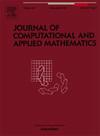Computationally efficient selection criterion of initial equation in STLN-based structured low-rank approximation
IF 2.1
2区 数学
Q1 MATHEMATICS, APPLIED
Journal of Computational and Applied Mathematics
Pub Date : 2025-04-19
DOI:10.1016/j.cam.2025.116703
引用次数: 0
Abstract
The problem of structured low-rank approximation (SLRA) of a given matrix arises in a wide range of applications. This problem can be solved by the structured total least norm (STLN) method, which formulates it as a linear equation called an “initial equation”. Because this equation directly impacts the performance of STLN-based SLRA, certain selection criteria have been proposed. However, these criteria are computationally intensive and their theoretical validity has not been sufficiently investigated. In this paper, we theoretically analyze the relationship between the original problem and an initial equation, and subsequently propose a novel selection criterion with a computational order of , in contrast to the complexity of incurred by conventional methods. We also demonstrate numerical experiments for Sylvester matrices to confirm that our selection criterion reduces not only the selection time of the initial equation, but also the overall calculation time of the STLN-based SLRA.
基于stn的结构化低秩逼近中初始方程的计算效率选择准则
给定矩阵的结构化低秩逼近(SLRA)问题有着广泛的应用。该问题可通过结构化总最小范数(STLN)方法求解,该方法将其表述为称为“初始方程”的线性方程。由于该方程直接影响基于stn的SLRA的性能,因此提出了一定的选择标准。然而,这些准则计算量大,其理论有效性还没有得到充分的研究。本文从理论上分析了原始问题与初始方程之间的关系,并提出了一种新的选择准则,其计算阶数为O(n3),而传统方法的复杂度为O(n4)。我们还对Sylvester矩阵进行了数值实验,证实了我们的选择准则不仅缩短了初始方程的选择时间,而且缩短了基于stn的SLRA的整体计算时间。
本文章由计算机程序翻译,如有差异,请以英文原文为准。
求助全文
约1分钟内获得全文
求助全文
来源期刊
CiteScore
5.40
自引率
4.20%
发文量
437
审稿时长
3.0 months
期刊介绍:
The Journal of Computational and Applied Mathematics publishes original papers of high scientific value in all areas of computational and applied mathematics. The main interest of the Journal is in papers that describe and analyze new computational techniques for solving scientific or engineering problems. Also the improved analysis, including the effectiveness and applicability, of existing methods and algorithms is of importance. The computational efficiency (e.g. the convergence, stability, accuracy, ...) should be proved and illustrated by nontrivial numerical examples. Papers describing only variants of existing methods, without adding significant new computational properties are not of interest.
The audience consists of: applied mathematicians, numerical analysts, computational scientists and engineers.

 求助内容:
求助内容: 应助结果提醒方式:
应助结果提醒方式:


